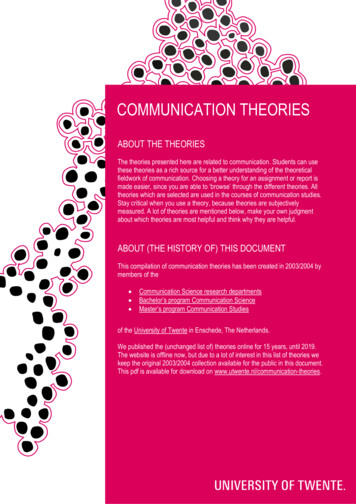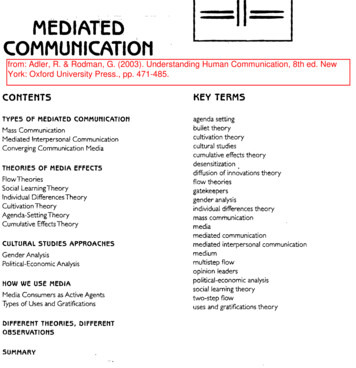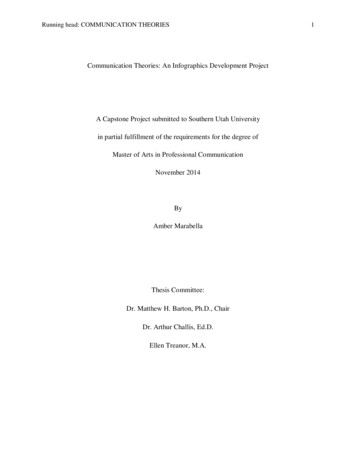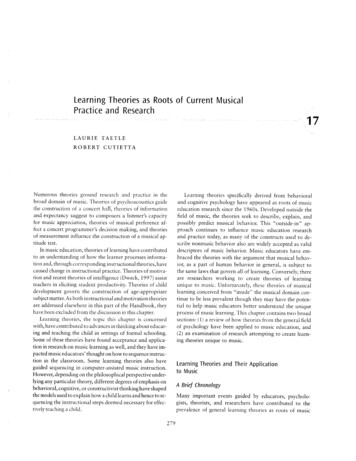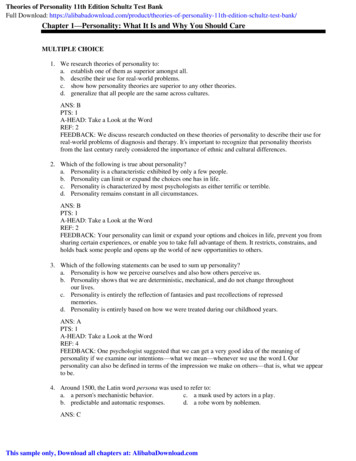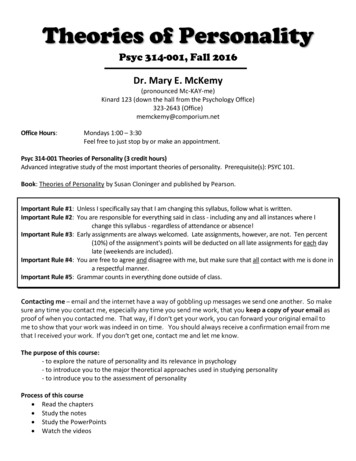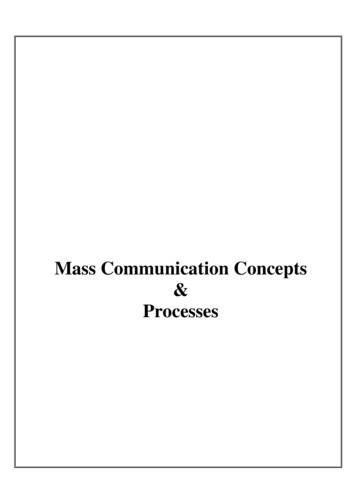
Transcription
Chapter 1Theories, tradi ons, and challenges —A new approachSverre Røed‐LarsenJohn StoopJan Erik Karlsen
Table of contents1.11.21.31.41.51.6Foresight in safety – taking actions for a change . . . . . . . . . . . . . . . . 331.71.7.1Corporate foresight . . . . . . . . . . . . . . . . . . . . . . . . . . . . . . . . . . . . . . . . . . . 33Introduction . . . . . . . . . . . . . . . . . . . . . . . . . . . . . . . . . . . . . . . . . . . . . . . . . . . 161.7.2Tools and techniques . . . . . . . . . . . . . . . . . . . . . . . . . . . . . . . . . . . . . . . . . 341.1.1Combining foresight and safety . . . . . . . . . . . . . . . . . . . . . . . . . . . . . . . . 161.7.3Foresight: from safety, via anticipation towards resilience . . . . . . . . 351.1.2Foresight, how it began . . . . . . . . . . . . . . . . . . . . . . . . . . . . . . . . . . . . . . . 161.7.4What next? . . . . . . . . . . . . . . . . . . . . . . . . . . . . . . . . . . . . . . . . . . . . . . . . . . . 371.1.3A sensitivity to overarching philosophies . . . . . . . . . . . . . . . . . . . . . . . 171.1.4Two worlds drift apart . . . . . . . . . . . . . . . . . . . . . . . . . . . . . . . . . . . . . . . . . 191.8.1Five major elements in the new approach . . . . . . . . . . . . . . . . . . . . . . . 371.1.5Feedback from reality . . . . . . . . . . . . . . . . . . . . . . . . . . . . . . . . . . . . . . . . . 201.8.2Implementing the foresight approach . . . . . . . . . . . . . . . . . . . . . . . . . . 371.1.6Three driving forces . . . . . . . . . . . . . . . . . . . . . . . . . . . . . . . . . . . . . . . . . . . 21Foresight in safety: the new approach . . . . . . . . . . . . . . . . . . . . . . . . . . 371.8Conclusions and recommendations . . . . . . . . . . . . . . . . . . . . . . . . . . . . . 381.9Thinking about the future . . . . . . . . . . . . . . . . . . . . . . . . . . . . . . . . . . . . . . 211.9.1Objectives in an uncertain and complex future . . . . . . . . . . . . . . . . . . 381.2.1Five different attitudes to future . . . . . . . . . . . . . . . . . . . . . . . . . . . . . . . 211.9.2Foresight and safety . . . . . . . . . . . . . . . . . . . . . . . . . . . . . . . . . . . . . . . . . . 381.2.2Theories and their scientific background . . . . . . . . . . . . . . . . . . . . . . . 21Foresight as an object of research. . . . . . . . . . . . . . . . . . . . . . . . . . . . . . . 221.3.1The time concept in foresight . . . . . . . . . . . . . . . . . . . . . . . . . . . . . . . . . . 221.3.2Brief outline of foresight traditions . . . . . . . . . . . . . . . . . . . . . . . . . . . . . 221.3.3A promising future for a new discipline . . . . . . . . . . . . . . . . . . . . . . . . . 23Safety: investigations and the ‘modern’ systems approach . . . . . . 241.4.1Safety in legacy and modern systems . . . . . . . . . . . . . . . . . . . . . . . . . . . 251.4.2Foresight in technological innovation: trends and opportunities . . 26Foresight in a World at Risk . . . . . . . . . . . . . . . . . . . . . . . . . . . . . . . . . . . . . 271.5.1The Coronavirus pandemic . . . . . . . . . . . . . . . . . . . . . . . . . . . . . . . . . . . . 281.5.2Any early warnings? . . . . . . . . . . . . . . . . . . . . . . . . . . . . . . . . . . . . . . . . . . . 281.5.3From micro-cosmos to macro-chaos . . . . . . . . . . . . . . . . . . . . . . . . . . . 291.5.4Revisiting the Risk Society in a world without a leader . . . . . . . . . . . 301.5.5Future global chocks and the need for resilience . . . . . . . . . . . . . . . . 301.5.6Chance favours the prepared mind . . . . . . . . . . . . . . . . . . . . . . . . . . . . . 31Foresight towards a full information paradigm . . . . . . . . . . . . . . . . . . 321.6.1A full information paradigm . . . . . . . . . . . . . . . . . . . . . . . . . . . . . . . . . . . . 321.6.2The Greek Triangle according to Godet . . . . . . . . . . . . . . . . . . . . . . . . . 331.10References . . . . . . . . . . . . . . . . . . . . . . . . . . . . . . . . . . . . . . . . . . . . . . . . . . . . . 39
1Theories, traditions, and challenges – A newapproach1.1IntroductionExecutive summary1.1.1Combining foresight and safetyDuring the work of various ESReDA project groups on safety, the topic has beenshifting. Starting in 1993 with exploring the early phases of the investigationprocess – as data collection and guidelines for investigation of accidents - to laterphases like dynamic learning as the follow-up from accident investigations. Thefocus on foresight represents a shift from reactive to proactive approaches. Whatare the origins of foresight as a pro-active notion, and how are they related tosafety?In this chapter we explore historical relations between safety, foresight,innovation, and policymaking. We also look at how these relations got lost overthe last two decades and how they can be restored. Socio-economic drivers,political philosophies, and social values shape foresight in safety. We have taken atop-down perspective to gain insights into these higher order forces.In this chapter we explore historical relations between safety, foresight,innovation, and policymaking. We also look at how these relations got lost overthe last two decades and how they can be restored. Socio-economic drivers,political philosophies, and social values shape foresight in safety. We have taken atop-down perspective to gain insights into these higher order forces.The chapter outlines the historical background of foresight, reviews the evolutionof foresight-theories, and lists the methods used. The time concept in foresight,foresight traditions, and futures research is described and analysed, as are therelationships between safety, investigations, and the modern system approach.The strategic triangle and resilience are also discussed.The chapter outlines the historical background of foresight, reviews the evolutionof foresight-theories, and lists the methods used. The time concept in foresight,foresight traditions, and futures research is described and analysed, as are therelationships between safety, investigations, and the modern system approach.The strategic triangle and resilience are also discussed.Sverre Røed-Larsen, SRL Health Safety Environment Consulting, Norway,John Stoop, Kindunos Safety Consultancy Ltd, the Netherlands,Jan Erik Karlsen, University of Stavanger, Norway.Among the recurrent themes discussed is the role of safety in legacy andinnovative systems, the full information paradigm in combining feedback and feedforward control of safety, and the role of resilience engineering.A discussion on the ‘Foresight in a world at risk’, illustrated by the 2020 coronaviruspandemic, stresses the need to be organised in order to safeguard resilience. Insummary: sense and learn from the past, make-sense and act in the present, andprepare for the unexpected future.The approach towards a safety foresight methodology and challenges is outlined,and examples given of foresight implementation in areas such as management,education, and learning.Finally, we suggest integrating several notions as building blocks for amultidisciplinary activity in the domain of safety and foresight. Recommendationsare made for a new holistic safety management based on feed-forward as well ason feedback information and insights.1.1.2Foresight, how it beganIn addressing the concept of foresight from a historical perspective, Martin (2010)clarifies various early interpretations and perspectives, originating from theScience, Technology and Society (STS) debates in the 1970’s. These STS debatesaimed to foreseeable effects of innovations to societal developments and theirproblem-solving potential for practical problems. Such innovations affected alarge-scale introduction of Nuclear Power Plants (NPP), Electronic Highway andDNA technology. Disasters in these areas were deemed to have unacceptableconsequences and should be addressed proactively in order to make them sociallyacceptable.According to Martin (2010) foresight is defined as:”a process by which one comes to a fuller understanding of the forces shaping thelong-term future which should be taken into account in policy formation, planningPage 16 of 252
and decision making. By clarifying input assumptions, one can come to a predictionof outputs which can be justified scientifically.”In this definition, the goal of foresight is to systematically survey all paths thatcould be developed and identify what options or alternatives are open. Thisprocess explicitly does not restrict itself to preferential options from a single actorperspective but covers all options from an evidence-based perspective. From thispoint of view, decisions of today create the future by taking actions (Martin 2010).Such foresight is based on an understanding of interrelations between science,technology, and society. It should help to stimulate public discussion of desirablefutures and of the role of government in such futures (Steed and Tiffin 1986).During its development, foresight has covered three domains of interest: technological innovations and their transition processes by industrialinitiatives;policy making, assessing the impact of decisions and actions of governancecontrol;foreseeable safety consequences of new technologies revealed by casebased learning.1.1.3A sensitivity to overarching philosophiesProjects on foresight were initiated in several highly industrialised countries: theUK, US, Canada, Japan, France, Germany, the Netherlands, and Australia. Martinobserves that the development of foresight was dominated by different countries’political and socio-economic philosophy (Martin 2010).In the USA and UK, the Reagan and Thatcherite ‘New Economy’ intended to ‘rollback the state’. The aim was to reduce governmental responsibilities in selectingpreferential priorities for policy making decisions on innovative developments. Theselection of winners and prioritising was left to ‘the market’. Foresight had no partof their privatisation and deregulation policy. In this political philosophy, there wasno need to identify and select scientific and technological priorities. In the UK—and to a lesser extent the US—a convenient framework of scientific notions wasdeveloped by social and organisational scientists as Reason, Rasmussen, Perrowand Turner. Safety became ‘emergent’ and unforeseeable due to ‘complexity’,while accidents became ‘normal’ after a period of ‘incubation’ (Stoop, 2020). Thisframework disculpated those with governance responsibilities, and maskedgovernmental failure of foresight in safety. It left foresight to those corporatelevels and gave them exclusive managerial responsibility for safety and risk control.Within the framework, safety was no longer a societal concern, but became anoperational performance indicator at a corporate level, submitted toefficiency/thoroughness trade-off considerations, balanced against other processindicators such as costs and lead-times. To this purpose a toolkit with ALARP (AsLow As Reasonably Practicable) criteria for accepting risks and safety cases wasdeveloped, in conjunction with Safety Management Systems with quantifiablesafety performance indicators.This neoliberal framework assumed confidence in a proper functioning of suchdelegated responsibility for safe operations and a fair-trade behaviour of each ofthe actors with respect to risk avoidance, liability, and expert knowledge (Pupulidy,2019). The shift in responsibility, from governmental oversight and control to selfregulation in industry, was based on the assumptions that substantive safetyknowledge was in the market and that governmental oversight of corporate safetymanagement processes would suffice.However, unforeseen vulnerabilities in these assumptions emerged over time,culminating in serious concerns about deregulation, privatisation, and a properfunctioning of Safety Management Systems (Farrier, 2017; Pupulidy, 2019): in disconnecting content from process, a shift occurred from a factual andactual performance control to compliance with standard operatingprocedures. Regulatory on-site inspections were replaced by functionaldemands on managerial processes.This shift also hampered feedback from anomalies, empirical disclosure ofdeviations, incidents, and accidents. Lessons learned from safetyinvestigation and recommendations at a sectoral level became detachedfrom corporate Safety Management System input (Farrier 2017). At thiscorporate level, a new set of performance indicators had to be developed,such as Safety II as the expression of Best Practices and learning fromsuccesses.Recognition of that a degree of operator variability is normal also indicateddifferences between Work As Intended - by management - and Work AsDone - by operators. This difference caused controversies about theacceptability of deviations and compliance with Operational Excellence(Winters 2017). Issues emerged on liability and accountability, culminating inlegislation on Corporate Manslaughter and Corporate Homicide.Page 17 of 252
Erosion of operator flexibility in task performance occurred, in particular inconditions deviating from optimal, and in crisis and disaster situations. Inaviation, a simultaneous operator training was reduced to operate understandard situations, accommodating a more flexible and cheaper transitionbetween configuration adaptations and software equipment versions in theoperating environment. This shift from competence-based operator skills tocompliance-based task performance eroded the notion of operator flexibilityin dynamic operating environments and conditions to a great extent. It led toseveral catastrophic accidents. In the aviation and maritime industries, ‘GoodAirmanship’ and ‘Good Seamanship’ came under pressure.A lack of agreement about operator performance, non-compliance withestablished safety standards, and exclusive managerial control created astigmatising role as whistle blowers. This count in particular for substantiveexperts and experienced first line operators in assessing safety criticalsituations that were beyond control and awareness of corporatemanagement.Several catastrophic events demonstrated that the neoliberal framework ofdelegating responsibilities tends to erode existing barriers and precautionarymeasures relied-on to prevent disaster. In particular, with the airplane modelBoeing 737, disruptive developments were introduced, supported by NextGeneration and MAX branding, while their certification was treated as onlyderivative. A decision-making tool for certification of derivativedevelopments proved to be lacking. The Boeing 737MAX crashes havebecome the salutary example of unforeseen consequences of deregulationand privatisation of the civil aircraft certification regime with stillunforeseeable global consequences for its revision and adaptation.With the emergence of deficiencies of the neoliberal New Economy philosophy, anext generation of safety management philosophies is under development as asuccessor of what behavioural scientists called the ‘old school of safety thinking’.With the acceptance of deviation as normal - inevitably manifesting itself byemergent properties - the safety debate shifted from the origin of deviations andcauses of mishaps towards recovery from such deviations and mitigation of theirpotentially catastrophic consequences. Most prominent in this ‘new school’ ofthinking at the organisational level is the notion of Resilience Engineering (Woodsand Hollnagel, 2006). At the level of governmental oversight, retrospectiveindependent safety investigations were institutionalised under the notion of‘Independent Investigations, a Citizen’s Right and Society’s Duty’ (VanVollenhoven, 2001).Since the ability to foresee deviation and taking precautionary measures wasdenied due to the assumed impenetrable and inherent complexity of sociotechnical systems, foresight as a notion was no longer incorporated in this safetydebate. This has had far reaching implications for managing the (scientific)knowledge base for enhancing safety in complex socio-technical systems. After aseemingly stable situation of validating assumptions and expectations, thesesystems seem to have reached their third and final phase of development (Minsky,1986). In this phase, a distinction between derivative and disruptive adaptations islacking, while profit-taking is no longer covered by future developments due to alagging investment in precautionary arrangements and scientific knowledgedevelopment (Minsky, 1986; Vincenti, 1990). According to Snowden (2007), sucha final phase may trigger a transition from complex systems into chaotic systems.Such a chaotic system potentially creates catastrophic interdependencies due toits reliance on operational feedback.As deficiencies of the New Economy philosophy become visible, a next generationof safety management philosophies is under development’. Most prominent in thisnew school of thinking is the notion of Resilience Engineering (Woods andHollnagel, 2006). Foresight as a notion, however, has yet to be incorporated in thissafety debate.Outside the Anglo-Saxon world, northern European countries have seen the safetyand risk debate take a different direction with respect to foresight. Based on theRhineland governance model (Stoop, De Kroes, and Hale; 2017), the debateadhered to a concept of cooperation and deliberation. Examples of this include theDutch consensual Polder model and the Scandinavian humanitarian philosophy ofVision Zero. These differences impacted the approach and development offoresight in safety as a societal and strategic value.In the Netherlands, several major projects were initiated by the government in thepublic debate on the desirable future and the role of government (Martin 2010).The emphasis was on forecasting the consequences of policy making with respectto introducing nuclear power, the electronic highway, water management, landuse planning and large railway infrastructure projects. Several ParliamentaryInquiries disclosed emergent market failures in realising these projects andinvoked the justification of governmental initiatives and interventions in thesePage 18 of 252
areas (TCI, 2004; Van Kleef, 2016). To facilitate technological transition strategies,network-based Public Private Partnerships were created. Contractual conditionsfor risk liability changed from DC (Design and Construct) to DBFMO (Design, Build,Finance, Maintenance and Operations), changing the financial accountabilityrelations and risk management responsibilities between public and privatepartners in such networks (TCI 2004). Along with these new contracting forms,privatisation and liberalisation became the norm.This development was in line with EU initiatives on R&D projects in Frameworkprogrammes, based on long-term planning, such as the EU Vision 2050. Such majorprojects were supported by the establishment of R&D institutes similar to theRAND Corporation in the USA, and the creation of research networks betweenacademies, industry, and universities. Educational courses were established, suchas a faculty of Technology, Policy and Management at Delft University ofTechnology. Leading multinationals, such as Philips, Shell, and Unilever, developedin-house methods for innovation and change management in cooperation withacademia and research institutes (Berkhout, 2000).In these developments, safety has competed poorly against other corporatepriorities such as environment, sustainability, circular economy, and climatechange challenges (TCI 2004). The decay of safety concerns coincided withcomplacency in government and industrial legacy sectors where safety hadachieved an outstanding performance level. Transport, nuclear power, and theprocess industry were assumed to be Non-Plus Ultra-Safe, leaving room for onlymarginal safety enhancements at very high costs (Amalberti, 2001).1.1.4Two worlds drift apartForesight on safety in the abovementioned sectors became disconnected fromtheir technological developments, while the scientific debates on safety shiftedfrom substantive assessments to managing process control, risk perception andrisk acceptance standards. Safety was assumed to approach a theoreticalasymptote value of 10e-7 which would leave residual risks as highly unlikely andtherefore, negligible. Consequently, there was no trigger to explore R&D needsand development in safety investigation methodology beyond accident modellingand Human Factors research. In the New Economy philosophy, process drives outcontent, market drives out knowledge. Even a question was raised whether safetyscience was superfluous to existing (social) disciplines or was a science at all (SafetyScience 2014).In the scientific debate on recognition of social sciences in the foresight domain, awide variety of different terminologies, paradigms and notions emerged (Martin2010). Simultaneously, a dialectic stall emerged in the safety debates, confrontingsafety notions and interpretations from a variety of perspectives (Safety Science2014, Stoop, Hale and De Kroes 2017). The variety in terminology createdconfusion and controversies in both domains (Martin 2010, Safety Science 2014).As stated by Martin (2010): terminology is vitally important in the social sciences.‘The emergence of a new term often heralds the identification of some newphenomenon, or at least the recognition of an existing phenomenon that, untilnow, has laid undetected by social scientists. He identifies several threats tocoining new and unique phrases: a particular choice of phrasing may either greatlyenhance the prospect or ruin the chances of that research having any appreciableimpact. It also may create problems in establishing intellectual property claims onintractable problems and cause loss of persuasive arguments to incorporateforesight in a political philosophy. Finally, while allocation a new and unique labelmay attribute newly discovered phenomena to the reputation of social scientists,it may give rise to priority disputes in their discipline and in such disputed cases,accusations of plagiarism among colleagues and discrediting or rejection ofscientific schools of thinking by practitioners (Martin 2010, Zimmermann et al.,2011; Stoop, 2019).A less virulent consequence of coining phrases is the gradual separation thatoccurs across scientific disciplines, in particular between engineering design andsocial sciences, where a ‘debate of the deaf’ occurred. Due to differences inlanguage, contexts and operating conditions, separations can also occur betweenvarious industrial sectors, academic debates and safety investigation practices.Such a separation can be observed with respect to safety between resilienceengineering, safety science and the aviation sector, each developing their ownreference framework, paradigms, methods, and tools (Zimmermann et al., 2011).A striking example of such a difference across sectors is present between theprocess industry and aviation, questioning whether there is a distinction or notbetween process safety, occupational safety, external safety, rescue andemergency safety at a governance or corporate level (Stoop 2019). Suchdifferences also created diverse problem definitions and problem-solvingstrategies across disciplines and application domains (Martin 2010). Suchdifferences also raise doubts about the extent to which the theories and notionsin foresight generalise to the field of safety, and vice versa.Page 19 of 252
1.1.5Feedback from realityEach of these disciplines and domains applied specific approaches, covering impactassessment studies, probabilistic risk assessment and safety management policies.Both legacy sectors and new technologies were submitted to such safety and riskassessments, focusing on perception and acceptance of either occupational safety,process safety, environmental safety, rescue and emergency, recovery andresilience, criticality and vulnerability issues (Van Kleef, 2016). Most of thesedebates were ad hoc and driven by events. Such managerial assessmentsconsidered residual risks. However, risks assessed as more remote than the 10e-7frequency limit, would be deemed negligible and their potential catastrophicconsequences expelled from the equation. Instead of understanding such events,the absence of investigating their nature and context caused ignorance about theircomplexity and dynamics. Devils in the details were not scrutinised. Furthermore,their social impact, public perception and acceptance were not considered in thedecision making on their acceptability. This managerial safety and risk philosophycreated a category of very low frequency/catastrophic consequence events whichwere not foreseen to their full extent but were nonetheless considered ‘normal’(Perrow 1999). Only in the 1990’s, after a series of iconic disasters, did theircriticality and social impact became the subject of academic interest.The 1990-2000 era revealed complacency in the governmental oversight of thiscategory of catastrophic events; concerns were raised about foreseeability andacceptability. Notions of prevention, proaction, recovery, resilience and foresightbecame buzzwords in the academic and policy making debate. Safety 2 was coinedas a proactive, complimentary ’new school’ notion for the reactive ‘old school’ ofsafety 1, accompanied with a plea for a paradigm shift in safety thinking (SafetyScience 2014, Stoop, De Kroes and Hale 2017).At the same time, several iconic accidents in the 1990-2000 era in the high-techindustries of various industrialised countries raised concerns about thepredictability and societal control over major safety and risk events. The mainexamples are noted, below. Several major air crashes occurred shortly after one another in theNetherlands: Bijlmer Boeing 747 (1992), Texel DC3 (1996), City Hopper,Schiphol (1994), Eindhoven Hercules (1996), while international TWA 800(1996) and Concorde (2000) crashes shook public confidence in aviation. In the railways, train crashes occurred in the UK at Clapham Junction (1988),Channel Tunnel (1996), Ladbroke Grove (1999), Hatfield (2000), in theNetherlands near Hoofddorp (1992), in Germany at Eschede (1998), and inNorway (2000).Passenger ferries capsized in 1987 (Herald of Free Enterprise) and 1994(Estonia), while severe oil spills occurred with the Exxon Valdez (1989), Braer(1993), Sea Empress (1996) and Erica (1999)Nightclub fires with large numbers of casualties occurred in Sweden(Gothenburg 1998) and the Netherlands (Volendam, 2000), while a fireworkexplosion in Enschede (2000) and a nitrate explosion in Toulouse (2001)destroyed a complete neighbourhoodIn the process industry, in 1976 the Seveso disaster and in 1984 the Bhopaldisaster occurred, while Harrisburg (1979) and Chernobyl (1986) disruptedthe nuclear energy sector.These accidents became iconic because they served as wake-up calls and triggersfor change in these industries and in the prevention of such events. Learning fromaccidents to prevent recurrence of similar events became a political topic in orderto restore public confidence in industrial sectors and regain governance controlover disastrous events and their aftermaths. Recovery from industrial disasterbecame relevant, while the Hurricane Katrina flooding stimulated resilienceengineering thinking in the public domain. In addition to already existing subjects,new policy domains were explored such as rescue and emergency, publicgovernance and oversight, prevention and proaction. In 1997 the Swedish Riksdag(Parliament) adopted the concept of Vision Zero; no fatalities in road safety as arisk acceptance policy making goal, while several countries took initiatives forestablishing independent safety investigation agencies. All across Europe,investigation agencies broadened their traditional perspective from the transportsector to other sectors of industry and public governance on either a single modeor multimodal and multisectoral basis. In 1993, the community of independentnational transport safety boards established an international network, the ITSA(International Transportation Safety Association). This sharing of experiences andlearning from each other by feedback from reality originated from theirexperiences with case based and evidence-based learning. Due to a series of majordisasters in various domains, the Netherlands took a leading role in thisdevelopment. Independent safety investigations became a governance role modelPage 20 of 252
for industrialised countries across the world under the motto of ‘IndependentSafety Investigations, a Citizens’ Right and Societies’ Duty’ (Van Vollenhoven,2001). Safety investigations into specific events provided the necessary feedbackfor prevention and proaction. This investigative approach was acknowledged bythe European Union (EU) by issuing a series of Directives, institutionalisingindependent safety investigation agencies in various sectors and domains.Foresight based on feedback from reality provides a powerful, plausible, andcredible retrospective approach. However, prospective foresight, based ontheoretical grounds and scientific methods, was not incorporated in thisknowledge network development.1.1.6Three driving forcesThis chapter identifies three higher order driving forces that govern relationsbetween foresight and safety. These offer a means for long term development.Each of these three forces is embedded in a specific context of the science,technology, and society (STS) debate: in societal policy making, foresight reflects the acceptability andsustainability of the consequences of new technologies and their socialbenefits; in technological innovation, foresight in industries assists the change andtransition management processes that introduce new industrialdevelopments and deliver their economic benefits; but, in the scientific domain, safety and foresight have become separatedisciplinary activities, both in feedback learning and in the feed-forwardassessment of new technologies.In conclus
of foresight-theories, and lists the methods used. The time concept in foresight, foresight traditions, and futures research is described and analysed, as are the relationships between safety, investigations, and the modern system approach. The strategic triangle and resilience are also discussed. 1.1.2 Foresight, how it began
